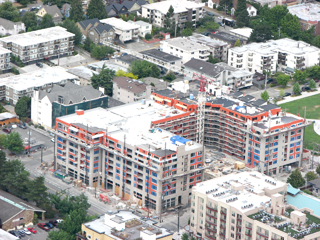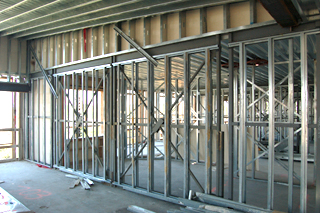
Surveys
DJC.COM
October 22, 2009
Ballard QFC requires unique structural solution
Swenson Say Faget

Bresko
|
When I told my mother and grandmother in 2003 that I was selected to do the structural engineering on a new apartment building in Ballard, they were not too thrilled. The new building was slated to replace the small aging neighborhood QFC. As local residents, they had been doing their shopping there for many years. However, they quickly came around when I reassured them that a bigger and more modern QFC would replace the original store.
At that point no one knew the struggles and joys that would lie in front of us over the course of the next six years.
Ballard on the Park is a 10-story mixed-use building that borders 24th Avenue Northwest to the west and overlooks the Ballard Commons Park to the east. The new 42,000-square-foot QFC, slated at street level, is sandwiched by seven stories of apartments above and two levels of below-grade parking. The building includes 268 apartments ranging in size from 570-square-foot studios to 1,200-square-foot townhouses.
QFC began tenant improvements in June and is planning to have the store open for Thanksgiving shopping. The apartments will be available in the late fall.
Challenging layout

Photos courtesy of Swenson Say Faget
Ballard on the Park will open later this year with 268 apartments, a grocery store and underground parking garage. |
Due to the building being taller than five stories, the code requires the structural systems to be non-combustible. This generally requires a concrete shear wall or steel-frame system. The advantage of both concrete shear walls and steel brace frames is that they can be designed to only occur at stair and elevator shaft locations, where they would remain in the same position at every level of the building.
Despite an average thickness between 12 and 18 inches and a slight slow-down in construction schedule, having the structure in one location throughout the building minimizes the overall impact to the architectural program. When making our choice, we considered aspects such as cost, weight, thickness and acoustic performance, among other issues. Additionally, and probably the most critical for us, was the seismic design and finding the best marriage between the lateral and vertical elements, ensuring adequate earthquake resistance while maintaining the construction budget.
After several months of schematic design, we were faced with the challenge of eliminating the seismic frames through the QFC space at street level. Due to the layout required for the store and parking garage, the stair and elevator shafts on these levels had to be placed at different locations from those on the apartment levels. Therefore, traditional concrete shear walls or steel-braced frame systems were no longer ideal.
Continuous frames are usually required on every level to keep each floor stable. When the frames don’t align from one level to another, the structural frame sizes as well as the construction costs increase rapidly.
At that point we began investigating the feasibility of a light-gauge steel framing option that could be supported by a thick concrete transfer floor over the QFC store. The design of many lighter shear-wall assemblies could be supported by a concrete floor without the need to align the walls on the apartment levels with the walls in the QFC space.
Taking this direction meant eliminating the design of heavily loaded large steel and concrete frames. We considered a number of shear wall systems such as, steel plates, Hardy Frame, Sure-Board and flat-strap tension bracing. Based on a variety of issues including constructability, performance and code issues, we were unable to find a traditional solution that fit our goals.
Our next step was to look at proprietary framing systems. A number of companies and products were considered including Inter Steel Structures Inc. (ISSI), a system we had worked with in the past.

Inter Steel Structures Inc. used light-gauge steel to make the modular framing system, which can be covered up with finishes such as drywall. |
ISSI produces a modular frame building system (MFBS) that uses light-gauge steel framing. Building components are fabricated at an off-site facility in custom lengths to suit the project goals, and then craned individually into position. Details of construction are pre-engineered to allow for the flexibility to integrate with all the varying structural floor systems. This results in reduced labor costs and increased construction speed.
Additionally, modifications to the system allowed us to meet the high lateral force demands of the project. This convinced us that ISSI’s product was an ideal choice for the building.
Hybrid system
Meeting the seismic demands alone was not sufficient enough reason to choose ISSI’s MFBS. The system has achieved some of the highest ratings in acoustic-, thermal- and fire-tested light-gauge assemblies. Despite these advantages, we were cautious about moving forward with the ISSI system. It had not been used in any buildings taller than five stories and the Ballard Park design consisted of seven stories of apartments.
However, close collaboration over the next two years with the ISSI team, project designers and the city of Seattle resulted in a modified system integrating a more traditional steel-brace-frame solution with the pre-fabricated wall assembly. The result was a newly developed hybrid system capable of meeting all of the project’s structural needs.
Over the course of the last six years, this project has been a true labor of love, and one that has marked a turning point in the way we approach the design process as well as our commitment to the rest of the project team. Seldom are we asked to simply fit our structure within the confines of the architectural lines. Rather, our clients are encouraging us to actively participate with members of both the design and construction teams in the conceptual phases of the project to investigate a variety of structural systems and construction techniques.
In these cases, determining optimal designs early goes a long way in meeting the overall pro forma of the project.
For Ballard on the Park, developer Security Properties, represented by managing director of development John Marasco, sought out a project team based on enthusiasm and personal commitment. I applaud the collective effort and leadership of Bumgarder, the project architect, led by Mark Simpson who kept us on task and never lost sight of the wonderful product we were creating. In addition, throughout the project, the general contractor Absher Construction found ways to improve the efficiency and constructability of the structural design.
I’m looking forward to shopping at the new QFC, and I’ll have my grandmother and mother with me in spirit when I do. They left us in 2005 and last August, respectively. I dedicate my work on this project to both of them.
Blaze Bresko, PE, SE, is principal of Seattle-based structural engineering firm Swenson Say Faget. He has more than 20 years of experience as a structural engineer and has been at Swenson Say Faget for 10. He has designed steel, concrete, masonry and wood structures for a wide variety of public- and private-sector projects.
Other Stories:
- Does your building measure up, energy wise?
- Green Building Council faces critical forest decision
- A welcoming new home for ACRS
- Dutch architects reinvent modular construction
- European contest spurs new ideas in sustainable design
- Architects step up to help developers
- How wayfinding signs can enhance your brand
- Knowing when to build and when to remodel
- Skyrocket your chances of winning contracts
- Can the Toyota design approach help make great places?
Copyright ©2009 Seattle Daily Journal and DJC.COM.
Comments? Questions? Contact us.